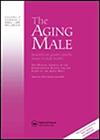Male subclinical hypogonadism and late-onset hypergonadotrophic hypogonadism: mechanisms, endothelial function, and interplay between reproductive hormones, undercarboxylated osteocalcin, and endothelial dysfunction
IF 2.7
4区 医学
Q3 ENDOCRINOLOGY & METABOLISM
引用次数: 1
Abstract
Abstract Background Pathogenesis and endothelial function in subclinical hypogonadism (SCH) remain unclear. Undercarboxylated osteocalcin (ucOC) participates in atherosclerosis and reproduction. We explored the underlying mechanisms and interplay of endothelial dysfunction, unOC and reproductive hormones in SCH and primary late-onset hypogonadism (LOH). Methods In the SCH, LOH, and healthy eugonadal male groups, we measured serum unOC, calculated luteinizing hormone/testosterone (LH/T), LH.T product, and estradiol/T (E/T) as indicators of impaired Leydig cells, androgen sensitivity index (ASI), and aromatase activity, respectively (LH set-point regulators), and assessed flow-mediated dilation of the brachial artery (FMD%), carotid-intima media thickness (CIMT), and aortic stiffness (AS). Results ↑LH/T, ↑ASI, ↓aromatase activity, normal T, follicle-stimulating hormone (FSH) and sex hormone-binding globulin (SHBG) levels, ↑unOC, and enhanced atherosclerotic markers (↓FMD%, ↑CIMT, ↑AS) are characteristics of SCH. Testosterone was positively correlated with FMD% in SCH. The independent predictors were: SHBG and LH for FMD% and CIMT, respectively, and LH/T, ucOC, FSH, estradiol, and E/T ratio for AS in the LOH group; and LH for FMD% & AS and LH and LH/T for CIMT in all study subjects. Conclusions SCH is a distinct clinical entity characterized by impaired androgen sensitivity and aromatase activity, compensatory elevated unOC, endothelial dysfunction, and anti-atherogenic role of testosterone.男性亚临床性腺功能减退和迟发性促性腺功能亢进:机制、内皮功能和生殖激素、低羧化骨钙素和内皮功能障碍之间的相互作用
背景亚临床性腺功能减退症(SCH)的发病机制和内皮功能尚不清楚。低羧化骨钙素(ucOC)参与动脉粥样硬化和生殖。我们探讨了内皮功能障碍、unOC和生殖激素在SCH和原发性迟发性性腺功能减退(LOH)中的潜在机制和相互作用。方法测定SCH组、LOH组和健康性腺正常男性血清unOC,计算黄体生成素/睾酮(LH/T)、LH。T产物、雌二醇/T (E/T)分别作为受损间质细胞、雄激素敏感性指数(ASI)和芳香化酶活性(LH设值调节剂)的指标,并评估肱动脉血流介导的扩张(FMD%)、颈动脉内膜中厚(CIMT)和主动脉硬度(as)。结果↑LH/T、↑ASI、↓芳香化酶活性、正常T、促卵泡激素(FSH)和性激素结合球蛋白(SHBG)水平、↑unOC和动脉粥样硬化标志物(↓FMD%、↑CIMT、↑AS)是SCH的特征。SCH中睾酮与FMD%呈正相关。独立预测因子为:LOH组FMD%和CIMT分别为SHBG和LH, AS为LH/T、ucOC、FSH、雌二醇和E/T比值;所有研究对象FMD% & AS的LH和CIMT的LH和LH/T。结论SCH是一种独特的临床实体,其特征是雄激素敏感性和芳香酶活性受损、代偿性unOC升高、内皮功能障碍和睾酮的抗动脉粥样硬化作用。
本文章由计算机程序翻译,如有差异,请以英文原文为准。
求助全文
约1分钟内获得全文
求助全文
来源期刊

Aging Male
医学-泌尿学与肾脏学
CiteScore
6.40
自引率
3.80%
发文量
33
审稿时长
>12 weeks
期刊介绍:
The Aging Male , the official journal of the International Society for the Study of the Aging Male, is a multidisciplinary publication covering all aspects of male health throughout the aging process. The Journal is a well-recognized and respected resource for anyone interested in keeping up to date with developments in this field. It is published quarterly in one volume per year.
The Journal publishes original peer-reviewed research papers as well as review papers and other appropriate educational material that provide researchers with an integrated perspective on this new, emerging specialty. Areas of interest include, but are not limited to:
Diagnosis and treatment of late-onset hypogonadism
Metabolic syndrome and related conditions
Treatment of erectile dysfunction and related disorders
Prostate cancer and benign prostate hyperplasia.
 求助内容:
求助内容: 应助结果提醒方式:
应助结果提醒方式:


